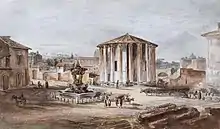William Douglas (died 1821)
William Douglas of Orchardton and Almorness FRSE (c. 1784 – 1821) was an advocate and a British Member of Parliament in the House of Commons.
William Douglas | |
|---|---|
| Member of Parliament for Plympton Erle | |
| In office 1812–1816 | |
| Preceded by | Ranald George Macdonald George Duckett |
| Succeeded by | Ranald George Macdonald Alexander Boswell |
| Personal details | |
| Born | c. 1784 Kirkcudbrightshire |
| Died | 1821 |
| Relations | Sir William Douglas, 1st Baronet (uncle) Douglas Robinson Sr. (nephew) Sir William Rose Robinson (nephew) |
| Parent(s) | James Douglas Elizabeth Douglas |
| Education | Edinburgh High School |
| Alma mater | Trinity College, Cambridge |
Early life
Douglas was born in Kirkcudbrightshire around 1784.[1] He was the son of James Douglas of Orchardton (1747–1821), a Glasgow merchant, and Elizabeth (née Douglas) Stevenson Douglas, who had previously been married to Captain William Stevenson, a distant cousin of his father. Among his siblings were sisters Mary Douglas (wife of William Rose Robinson) and Matilda Douglas (wife of William Maitland).[2]
His paternal grandparents were John Douglas, a Galloway farmer, and Mary (née Heron) Douglas and his maternal grandfather was William Douglas of Worcester.[2] Through his sister, he was uncle to Douglas Robinson Sr. (who married Fanny Monroe, daughter of U.S. Representative James Monroe and a grand-niece of U.S. President James Monroe) and Sir William Robinson, KCSI, who served as acting Governor of Madras.[3]
He was educated at Edinburgh High School and Trinity College, Cambridge.[1]
Career
He was called to the Scottish Bar in 1806.[4] Alongside his uncle, Sir William Douglas of Castle Douglas, he was a partner in the Galloway Banking Co. (Douglas, Napier, & Co), established in Castle Douglas in 1806 and which ceased trading in 1821, because of a bad debt.[5]
He was president of the Speculative Society between 1806 and 1809.[6] An active Christian, he represented his parish as Ruling Elder at the Annual Meeting of the General Assembly of the Church of Scotland in 1811.
Having previously tried for Kirkcudbright, but been rejected, he was subsequently elected as member of Parliament for Plympton Erle from December 1812 to June 1816, during which time he is not known to have spoken, and has just seven recorded votes.[7]
In 1812, he was elected a Fellow of the Royal Society of Edinburgh. His proposers were Thomas Allan, Allan Maconochie, Lord Meadowbank, and John Playfair.[1]

Around 1816–1818, he accompanied the artist Hugh William Williams on a tour of continental Europe, which he (Douglas) funded and during which he also made paintings in his own right.[8]
Personal life
Douglas died unmarried in 1821. Involved in the design of the Douglas Mausoleum in Kelton, near Castle Douglas, he was interred there following his death on 9 July 1821, alongside other family members.[9]
References
- Biographical Index of Former Fellows of the Royal Society of Edinburgh 1783–2002 (PDF). The Royal Society of Edinburgh. July 2006. ISBN 0-902-198-84-X.
- "James Douglas of Orchardton, 1747-1821". www.douglashistory.co.uk. Retrieved 28 April 2020.
- Buckland, Charles Edward (1906). Dictionary of Indian biography. London S. Sonnenschein. p. 362. Retrieved 28 June 2018.
- History of the Speculative Society of Edinburgh By Speculative society of Edinburgh
- Bank of Scotland: a history, 1695-1995 By Richard Saville
- History of the Speculative society of Edinburgh By Speculative society of Edinburgh
- The House of Commons 1790-1820 By Roland G. Thorne, History of Parliament Trust
- "The List". Abbott and Holder. Archived from the original on 7 July 2021.
- Mausoleums By Lynn F. Pearson